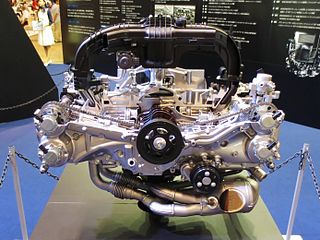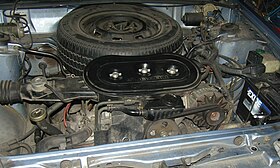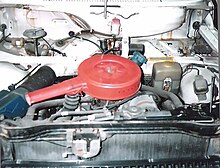
A carburetor is a device used by a gasoline internal combustion engine to control and mix air and fuel entering the engine. Carburetors can be quite complex but the primary method of adding fuel to the intake air in the main metering circuit is through the pressure difference using the Venturi effect from two separate holes in the air flow or from Bernoulli's principle at the fuel orifice and ambient air pressure from a vent for the fuel bowl or the Pitot pressure at the air entry into the carburetor.

The Subaru Rex is a kei class automobile manufactured and marketed for model years 1972-1992 by Subaru primarily for the Japanese Domestic Market, although it was also sold in Europe, South America, Australia and the Caribbean — variously as the Ace, Viki, Sherpa, 500/600/700, Mini Jumbo, Mini Subaru or M60/M70/M80.

The LA engine is a family of overhead-valve small-block 90° V-configured gasoline engines built by Chrysler Corporation between 1964 and 2003. Primarily V8s, the line includes a single V6 and V10, both derivations of its Magnum series introduced in 1992. A replacement of the Chrysler A engine, they were factory-installed in passenger vehicles, trucks and vans, commercial vehicles, marine and industrial applications. Their combustion chambers are wedge-shaped, rather than polyspheric, as in the A engine, or hemispheric in the Chrysler Hemi. LA engines have the same 4.46 in (113 mm) bore spacing as the A engines.

The Chevrolet small-block engine is a series of gasoline-powered V8 automobile engines, produced by the Chevrolet division of General Motors in two overlapping generations between 1954 and 2003, using the same basic engine block. Referred to as a "small-block" for its size relative to the physically much larger Chevrolet big-block engines, the small-block family spanned from 262 cu in (4.3 L) to 400 cu in (6.6 L) in displacement. Engineer Ed Cole is credited with leading the design for this engine. The engine block and cylinder heads were cast at Saginaw Metal Casting Operations in Saginaw, Michigan.

The GA engine is a 1.3 to 1.6 L inline-four piston engine from Nissan. It has a cast-iron block and an aluminum head. There are SOHC and DOHC versions, 8, 12, and 16 valve versions, carbureted, single-point, and multi-point injected versions, and versions with variable valve timing (GA16DE). The GA was produced from August 1987 through 2013. Since 1998, it was only available from Mexico in the B13.

The Subaru Leone is a compact car produced by the Japanese car manufacturer Subaru from 1971 to 1994. The word leone is Italian for lion.

The CA engine is a series of 1.6 to 2.0 L Inline-4 piston engines from Nissan. It is designed for a wide variety of smaller Nissan vehicles to replace the Z engine and some smaller, four-cylinder L series engines. The "CA" stands for Clean Air, due to the installation of Nissan emission reducing technology, called NAPS-X.

An inlet manifold or intake manifold is the part of an internal combustion engine that supplies the fuel/air mixture to the cylinders. The word manifold comes from the Old English word manigfeald and refers to the multiplying of one (pipe) into many.

The Subaru XT is a two-door, front- or all-wheel drive, four passenger 2+2 coupé manufactured and marketed by Subaru for model years 1985-1991, with a facelift in 1987. At introduction, the XT was the most aerodynamic car marketed in the US market, heavily influenced by noted designer Alex Tremulis.

The E-series was a line of inline four-cylinder automobile engines designed and built by Honda for use in their cars in the 1970s and 1980s. These engines were notable for the use of CVCC technology, introduced in the ED1 engine in the 1975 Civic, which met 1970s emissions standards without using a catalytic converter.

The Honda A series inline-four cylinder engine is used in 1980s Honda Accord and Prelude models. It was introduced in 1982, with the second-generation Honda Prelude, and available in three displacement sizes: 1.6-, 1.8- and 2.0-liters. It features cast iron block and aluminum SOHC head design with three valves per cylinder for a total of 12 valves. It was available in carbureted and fuel-injected configurations

The Suzuki G engine is a series of three- and four-cylinder internal combustion engines manufactured by Suzuki Motor Corporation for various automobiles, primarily based on the GM M platform, as well as many small trucks such as the Suzuki Samurai and Suzuki Vitara and their derivatives.

The Subaru EJ engine is a series of four-stroke automotive engines manufactured by Subaru. They were introduced in 1989, intended to succeed the previous Subaru EA engine. The EJ series was the mainstay of Subaru's engine line, with all engines of this series being 16-valve horizontal flat-fours, with configurations available for single, or double-overhead camshaft arrangements. Naturally aspirated and turbocharged versions are available, ranging from 96 to 310 hp. These engines are commonly used in light aircraft, kit cars and engine swaps into air-cooled Volkswagens, and are also popular as a swap into Volkswagen T3/Vanagons powered by the Volkswagen Wasserboxer engine. Primary engineering on the EJ series was done by Masayuki Kodama, Takemasa Yamada and Shuji Sawafuji of Fuji Heavy Industries, Subaru's parent company.
The following outline is provided as an overview of and topical guide to automobiles:

The Chevrolet 90° V6 family of V6 engines began in 1978 with the Chevrolet 200 cu in (3.3 L) as the base engine for the all new 1978 Chevrolet Malibu. The original engine family was phased out in early 2014, with its final use as the 4.3 L (262 cu in) V6 engine used in Chevrolet and GMC trucks and vans. Its phaseout marks the end of an era of Chevrolet small-block engine designs dating back to the 1955 model year. A new Generation V 4.3 L (262 cu in) V6 variant entered production in late 2013, based on the LT1 small block V8 and first used in the 2014 Silverado/Sierra 1500 trucks.

The Subaru FB engine is the third generation of gasoline boxer-4 engine used in Subaru automobiles, and was announced on 23 September 2010. It follows the previous generation EJ-series engine which was introduced in 1989 and the first generation EA-series which was introduced in 1966. By increasing piston stroke and decreasing piston bore, Subaru aimed to reduce emissions and improve fuel economy, while increasing and broadening torque output compared to the EJ-series.

The Subaru FA engine is a gasoline boxer-4 engine used in Subaru and Toyota automobiles. It is a derivative of the FB engine, with efforts to reduce weight while maintaining durability as the main design goals. Although the FA and FB engines share a common platform, the FA shares very little in dedicated parts with the FB engine, with a different block, head, connecting rods, and pistons.
The Subaru six-cylinder engines are a series of flat-6 engines manufactured by Subaru, made in three distinct generations. The ER27, derived from the Subaru EA first-generation flat-4, was used as the sole engine option in the premium model 1988–91 Subaru Alcyone VX. The EG33, derived from the Subaru EJ second-generation flat-4, was used exclusively in the successor Subaru Alcyone SVX, again as its sole engine option, sold from 1991–96. The EZ series, consisting of the EZ30 and EZ36 models, was designed to be almost as compact as the EJ25 flat-4. The EZ30/36 were the first Subaru six-cylinder engines available outside the sport coupes, used as the uplevel option for Subaru Legacy (2002–19) and Outback/Lancaster (2001–19) as well as the sole option in the Subaru Tribeca (2006–14).



















